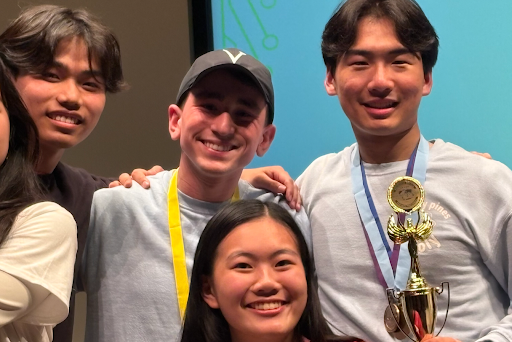
Left to right: The Science Olympiad team officers, Yuta Hakozaki (12), Jack Fulkerson (12), Lucy Huang (11) and Anthony Kim (11) attend the awards ceremony at the San Diego Regionals. Fulkerson and Kim received fourth (Microbe Mission) and first place (Experimental Design), respectively. Photo courtesy of Anthony Kim.
The school’s Science Olympiad team placed No. 4 at the San Diego Regionals held at the University of California, San Diego on March 15 and No. 16 at the Science Olympiad State Tournament held at Caltech on April 12.
To determine a school’s ranking, all placements are added together to yield their score; the lower their points, the higher the placement. At regionals, the school had a score of 277, which is an 11-point improvement from the previous year. They also placed top five in seven events including first in Experimental Design, second in Robot Tour, third in Disease Detectives, Geologic Mapping and Optics, fourth in Microbe Mission and fifth in Wind Power.
“Our fourth-place finish at regionals is a testament to the team’s hard work and dedication,” Jack Fulkerson (12), the Science Olympiad team coordinator, said. “We were against some tough teams this year and had some challenging issues but we persevered and had a really strong finish.”
The team had a strong season leading up to regionals at the Stanford University and UCSD invitationals, earning many top three finishes in multiple events.
“Partners for events met multiple times in the months leading up to the competition,” Fulkerson said. “We also had a lot of students compete at the Stanford and UCSD invitationals, which helped us prepare substantially due to their more challenging tests.”
The students are split into partners who have to work together and collaborate in each event. Some notable students on the team include Stella Jeong (9) and Anthony Kim (11), who placed first in Experimental Design, and Fulkerson and his partner Vera Muller (9), who placed fourth in Microbe Mission at the regional competition.
“We prepared by getting together with our partners before the competition,” Jeong said. “We split the work accordingly so each team member could contribute the most to the overall result.”
Many Science Olympiad events include hands-on lab events such as building or performing labs, where students are not aware of what to expect until the event begins.
“One of the challenges of regionals was for my event experimental design,” Kim said. “For lab events, it’s all about communication and understanding how your partner works to be prepared on the day of the competition. It’s not something where they give you an overall idea of what to do, and on the day of the competition you don’t know what to expect. Usually for Experimental Design, it’s a physics lab, and you have to develop an experiment, but for regionals, it was a chemistry topic, baking soda and vinegar, which is a lot messier, so time was harder to maintain.”
With a top five finish at regionals, the team qualified for the Science Olympiad State Tournament. As the state tournament approached, the team intensified their practices in order to reach their desired goal of placing in the top ten. They took No. 16 out of 31 teams with an overall score of 380.
“For states, I will prepare by reviewing materials and practicing with my partners,” Jeong said in an interview before the tournament. “My goals are to get first at state for my events to allow our team to get a good ranking overall.”
At states, they ranked three places higher than the previous year.
“Our team has grown incredibly this year,” Kim said. “Our performance at states highlights the dedication of our competitors and coordinators. We’ve been working to build a strong, more spirited Science Olympiad community at TP, and we are excited to keep this momentum going next year.”